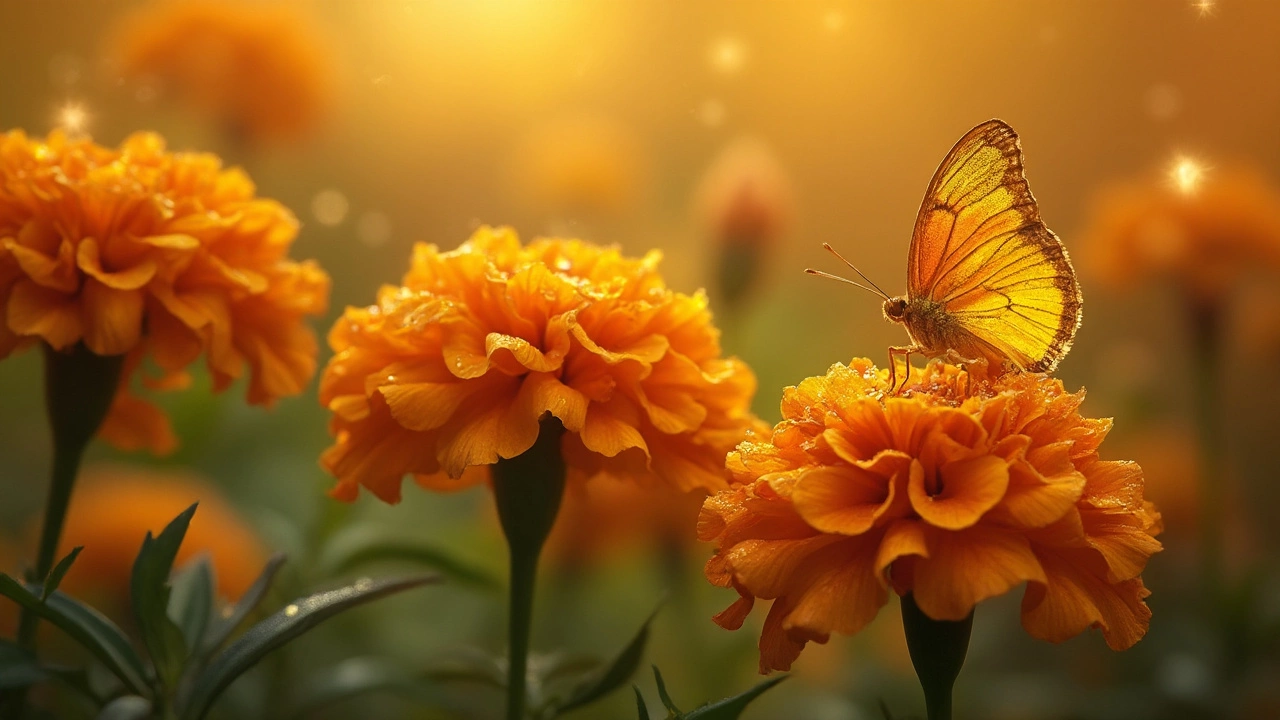When it comes to lucky charms in the garden, the marigold steals the spotlight in India. This flower is more than just a splash of color; it’s a beacon of joy and prosperity. You’ve probably spotted marigolds at weddings, festivals, and even tucked behind deities in temples. Ever wondered why they’re everywhere? Well, it's not just because they're pretty.
The marigold is fondly called the 'Herb of the Sun' in many cultures, symbolizing warmth and positive energy. In India, marigolds are thought to ward off negative vibes while attracting good fortune. With such a reputation, who wouldn’t want to plant a few?
If you’re planning to add this golden bloom to your space, marigolds are thankfully a breeze to grow. They’re tough, handling the Indian sun without a sweat, and they require very little fuss to flourish. Whether you're a seasoned gardener or just starting out, marigolds are your go-to for both beauty and luck.
- What Makes the Marigold Lucky
- Growing Marigolds in Your Garden
- Symbolic Meanings Across Cultures
- Practical Tips for Marigold Care
What Makes the Marigold Lucky
You might be wondering why the marigold holds such a special place in Indian culture. In fact, its status as the luckiest flower comes from a mix of practicality, symbolism, and tradition.
Cultural Significance
In India, the marigold is deeply woven into cultural and religious fabrics. These flowers are used in numerous Hindu rituals and ceremonies, often seen adorning religious idols and offerings. They’re believed to please the gods and attract cosmic blessings.
Symbolism and Beliefs
The vibrant hues of marigolds resonate with energy and warmth. According to traditional beliefs, these colors help in keeping negative energies at bay while welcoming positivity and prosperity. In rural areas, it's common to see marigold garlands hung at entries to homes and businesses as a protective charm.
Scientific Benefits
Beyond cultural beliefs, marigolds have practical uses that make them a gardener's favorite. Known for their pest-repellent qualities, they keep bugs away naturally, which boosts the health of other plants. So, adding marigolds not only looks great but is also a smart gardening strategy.
| Season | Blooming Period |
|---|---|
| Spring | March - May |
| Summer | June - August |
Whether you’re drawn to them for their spiritual significance or practical benefits, planting marigolds could bring you more than just visual pleasure. They could just be the good luck charm your garden needs.

Growing Marigolds in Your Garden
Planting marigolds isn't rocket science, but there are a few tricks to help them thrive and bring that prosperity into your garden. Marigolds are pretty forgiving, which is great if you're just starting out!
Best Conditions for Growth
First off, you’ll want to pick a sunny spot. Those beauties love basking in the Indian sun. A good 6-8 hours of sunlight a day is ideal, but they can still manage with slightly less. As for soil, these luckiest flowers prefer well-drained soil. If you're dealing with clay-heavy ground, mix in some sand or compost to lighten it up.
Planting Steps
- Choose the right time: The best time to sow marigold seeds is just before the rainy season begins, around late spring.
- Starting seeds: Either sow the seeds directly in the ground or start them indoors a few weeks earlier. Sow seeds about 1/2 inch deep and keep them moist until germination, which takes about 4-14 days.
- Spacing: Give them some room to breathe—space them about 8-10 inches apart to prevent fungus.
Caring for Your Marigolds
Watering is key, but don't overdo it. Too much water can lead to root rot. Give them a drink when the top inch of soil feels dry. A monthly feeding with a balanced fertilizer or compost tea helps keep them happy and bushy.
Deadhead those blooms! Snipping off faded flowers encourages more blooms and keeps your garden looking neat. They can also keep certain pests away, but watch out for slugs and snails—those guys love marigolds.
Marigold Varieties
There are a bunch of nice types to choose from. French marigolds stay small and are perfect for borders. African marigolds get taller, up to 3 feet, and put on a show with their big, bold blooms. Mix and match to keep your garden buzzing with color!

Practical Tips for Marigold Care
Want to keep those bright blooms happy and thriving? Marigolds are relatively easy to care for. Here’s how you can ensure they stay in top shape:
1. Ideal Planting Spot
Marigolds love the sun, just like we do. Find a sunny spot with at least six to eight hours of sunlight daily. They prefer well-drained soil, so make sure there’s no standing water around.
2. Water Routine
These flowers are pretty chill about water but don’t let them dry out completely. Water them when the top soil feels a bit dry, but don’t soak them. Too much moisture can lead to root rot, and nobody wants that.
3. Feeding Frenzy
Feeding marigolds isn’t a big deal. A balanced fertilizer, once a month, is enough. If you're using organic compost, go easy since too much can encourage leafy growth over blooms.
4. Pest Patrol
Marigolds like to handle pests themselves—attracting beneficial insects that keep the bad ones away. Still, if you notice aphids or spider mites, a gentle spray of soapy water will do the trick.
5. Deadheading for the Win
To keep your marigolds blooming, pinch off the dead flowers. This encourages new growth and keeps your plants looking neat. Don’t worry, it sounds scarier than it is.
6. Watch Out for Weather
If you’re in an area with extreme heat, consider a bit of afternoon shade for your marigolds. They’re tough but not invincible. A bit of protection goes a long way in keeping them healthy.
Whether you’re a gardening newbie or a seasoned pro, marigolds are a great addition to your garden. Follow these tips, and you'll be rewarded with blooms that not only look great but also bring a bit of that lucky charm into your life.

